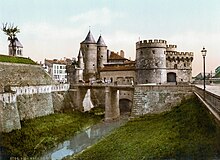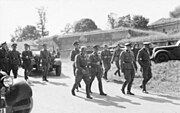Metz fortress

The city of Metz in Lorraine has a history of more than 2000 years as a military base or as a fortress. For centuries it was one of the most important fortified towns in Europe.
Metz has always been an important traffic junction : this is where four highways meet ( coming from the north ( Thionville , Luxembourg ), south ( Nancy , Épinal ), east ( Saarbrücken , Kaiserslautern , Saarland ) and west ( Verdun , Reims )) and there the Seille into the Moselle . From 1845 the French Eastern Railway built a railway network in the east of France . Around 1852 Metz was connected to the Paris – Strasbourg line ; In 1859 the Metz – Luxembourg railway was put into operation.
After 1871 the German Empire built some strategic railway lines : the cannon railway from Koblenz to Metz, the Metz – Château-Salins railway line (opened in 1904) and the Metz – Anzeling railway line (opened in 1908).
(This article uses the German designations for the systems. The French are in square brackets.)
Roman and Middle Ages
When Roman troops in 52 BC When they came to Metz towards the end of the Gallic War , they set up a military stage there. It grew into a sizable settlement over time. The first walled wall was built around 300 AD. Around 900 the place received a new, reinforced fortification, which was further expanded in the 12th century. Bishop Robert I of Metz is named here as the driving force. In 1445 the German Gate (still in place today) was built as one of seven castle gates (a fortified gate system with an outer and an inner gate and an intermediate kennel ).
French period 1552–1871
After the city was taken over by French troops (→ Treaty of Chambord ), a citadel was built in the south of Metz in 1556–1562 . In 1674, under the direction of the fortress builder Vauban, a new fortification that lasted until the end of the 17th century began, which was completed between 1728 and 1749 by his pupil Louis de Cormontaigne , Maréchal de camp and director of the fortresses. Among other things, the works of the Double Couronne du Fort Moselle and Belle Croix in the east and northwest, which were advanced between 1728 and 1740, further strengthened the fortress. In order to be able to occupy the fortress Metz with troops, the Caserne Coislin was built between 1726 and 1730 on the Champ à Seille. Metz became the strongest fortified city in France . In order to make room for even more systems, the walling from the Middle Ages was put down from 1742. The planned extensions did not take place for a long time; It was not until 1867 that the construction of the first fort belt around the city began, the design of which goes back mainly to General Séré de Rivières and provided for six forts: Ostfort [Diou] , Alvensleben [Plappeville] , Manteuffel [St. Julien] , Zastrow [Les Bolles] , Goeben [Queuleu] and August v. Württemberg [St. Private] . Only the work on the east fort [Diou] was almost finished at the beginning of the war in 1870/71 .
The reasons for the start of construction included Prussia's increase in power after its victory in the German War (1866) and the Luxembourg crisis in 1867.
German period 1871–1918

Mainly for reasons of time - they wanted to be able to defend the newly won areas as quickly as possible with appropriate systems - the Germans initially completed the unfinished or planned fortifications after 1871:
The east fort [Diou] was extended by a second, Fort Manstein [Girardin] . Both together formed the feast of Prince Friedrich Karl [Saint Quentin] . Construction time here was from 1867 to 1880. The forts Feste Alvensleben [Plappeville] (1867–1874), Fort Manteuffel [St. Julien] (1867–1875), Fort Goeben [Queuleu] (1867–1875) were built according to French plans. The forts Zastrow [Les Bordes] (1874–1875) and Feste Prinz August von Württemberg [St. Privat] (1872–1875) were planned by the French, but both were built according to German designs by Hans Alexis von Biehler . The forts Schwerin [Decaen] (1878–1880) and Hindersin [Gambetta] (1879–1881), both actually only intermediate works, as well as the fort Kameke [Déroulède] (1876–1879) completed what was now the first fort belt of the city of Metz in the north-west. Due to the explosive grenade crisis , it was subsequently forced to move the artillery from the fortifications into the spaces in between. By 1899, 65 infantry, ammunition and artillery rooms and 70 field batteries were built. As a final measure to secure the first fort belt, two 21 cm armored batteries were built between 1890 and 1893. In 1899, work began on the second ring, which mainly consisted of a newly developed type of fortress - the festivals , which ultimately made Metz the strongest fortress city in the German Empire . This outer, second ring of fortifications, about ten kilometers from the city, consisted of the following facilities: Mey infantry factory [Champagne] (1907–1912), Bellecroix infantry factory [Lauvalliere] (1908–1914), Feste von der Goltz [La Marne] ( 1907–1912) 1916), Chesny-Nord and Chesny-Süd infantry works (1907–1911), Luitpold [l'Yser] (1907–1910), Wagner [l'Aisne] (1907–1910), Haeseler [Verdun] (1899 –1905), Feste Kronprinz [Driant] (1899–1905), Infanteriewerk Marival (1912–1916, remained unfinished), Bois la Dame (1913–1916), Feste Kaiserin [Jeanne d'Arc] (1899–1908), Feste Leipzig [François de Guise] (1907–1913) and Feste Lorraine [Lorraine] (1899–1905). Also this ring was u. a. reinforced by concrete trenches ( Wolffsberg , Steinbruch and Horimont positions) and 10 and 15 cm batteries.
Governors
| Rank | Surname | date |
|---|---|---|
| Lieutenant General | Julius von Loewenfeld | October 28, 1870 to June 26, 1871 |
| Lieutenant General | Georg Ferdinand von Bentheim | July 15, 1871 to March 7, 1873 |
| Lieutenant General | Adolf von Glümer | March 8 to October 10, 1873 |
| Lieutenant General / General of the Infantry | Christoph von Schmidt | October 11, 1873 to November 11, 1876 |
| Lieutenant General / General of the Infantry | Kurt von Schwerin | November 19, 1876 to April 13, 1884 |
| Lieutenant General | Emil from Conrady | April 15, 1884 to November 2, 1885 |
| Lieutenant General | Rudolf von Bercken | November 3, 1885 to January 26, 1888 |
| Lieutenant General / General of the Infantry | Rudolf von Oppeln-Bronikowski | January 27, 1888 to March 19, 1890 |
| Lieutenant General / General of the Infantry | Emil von Fischer | March 24, 1890 to March 12, 1894 |
| Lieutenant General / General of the Infantry | Arno from Arndt | March 17, 1894 to July 6, 1896 |
| Lieutenant General / General of the Artillery | Anton von Froben | July 18, 1896 to May 2, 1901 |
| Lieutenant General / General of the Infantry | Louis Stoetzer | May 3, 1901 to May 17, 1903 |
| General of the cavalry | Maximilian von Hagenow | 1903 to 1906 |
| Lieutenant General / General of the Infantry | Hans von Arnim | 1906 to March 2, 1910 |
Fighting

Neither in the war of 1870/71 (→ Siege of Metz ) nor in the First World War , the fortifications of the city of Metz were actively involved in the battle. Only the Kronprinz and Haeseler festivals fired a few times. In the 1930s, the French army set up some command post of the Maginot Line in Metz . In the battle for Metz in late summer 1944, the German Wehrmacht used some of the old fortifications and offered the 3rd US Army an unexpectedly long resistance.
The fortresses today
Most of the facilities are abandoned. Some are used by the French army as camps or military training areas. The forts Goeben [Queuleu] and Hindersin [Gambetta] are used as recreational areas (fitness trail). In Fort Goeben a small museum recalls the there in the Second World War located concentration camps . The Feste Wagner [Groupe fortifie l'Aisne] can be visited.
→ Festival of Prince August of Württemberg
literature
- Charles Hoeffel: Heroes and martyrs of the Lorraine resistance movement in the SS special camp Fort Queuleu-Metz. Place of cruel Nazi torture methods. Self-published, Strasbourg 1946.
- Volkmar Braun, Frank Gosch: 1911–1913. The secret memorandum of the Prussian engineering committee . In: The fortress . No. 7 . Unna 1996.
- Raymond Decker : The "Feste Wagner" - An example of renovation and use from the Metz fortified belt. In: Hans-Rudolf Neumann (arrangement): Preservation and use of large historical fortresses. Philipp von Zabern, Mainz 2005, ISBN 3-8053-3511-3 , p. 97 ff.
- Christian Dropsy: Les fortifications de Metz et Thionville . Bruxelles 1995.
- Alain Hohnadel: La bataille des Fort Verdun face à Metz . 1995, ISBN 2-84048-087-5 .
- Rudi Rolf: The German tank fortification . Osnabrück 1991, ISBN 3-7648-1784-4 .
- Rudi Rolf: The development of the German fortress system since 1870 . Tweede Exloermond 2000, ISBN 90-76396-08-6 .
- Pierre Rhode: Metz 1870-1918 . In: Fortification . No. 5 , 1990, ISSN 0931-0878 , pp. 3-13 .
- Inge and Dieter Wernet: The Feste Wagner. ADFM 2002.
- Inge and Dieter Wernet: The Feste Wagner. ADFM, Helios-Verlag, Aachen 2010, DNB 1048437744 .
- H. Friedrich: Chronicle sheets of the Protestant military community in Metz. For the 25th anniversary of the Garrison Church , published by G. Scriba, Metz 1906, p. 81 ff.
Web links
- Feste Wagner - German side
- Festivities Wagner - l'Aisne
- German fortresses around Metz
- German fortresses around Metz from 1870 to 1918.
- Documentation and photographic impressions of today's fortresses.
Individual evidence
- ↑ Claus von Bredow: Historical ranking and master list of the German army. Verlag August Scherl, Berlin 1905, p. 840.
- ^ Feste Wagner. ( Memento from February 15, 2013 in the Internet Archive ) on: festungsbauten.de